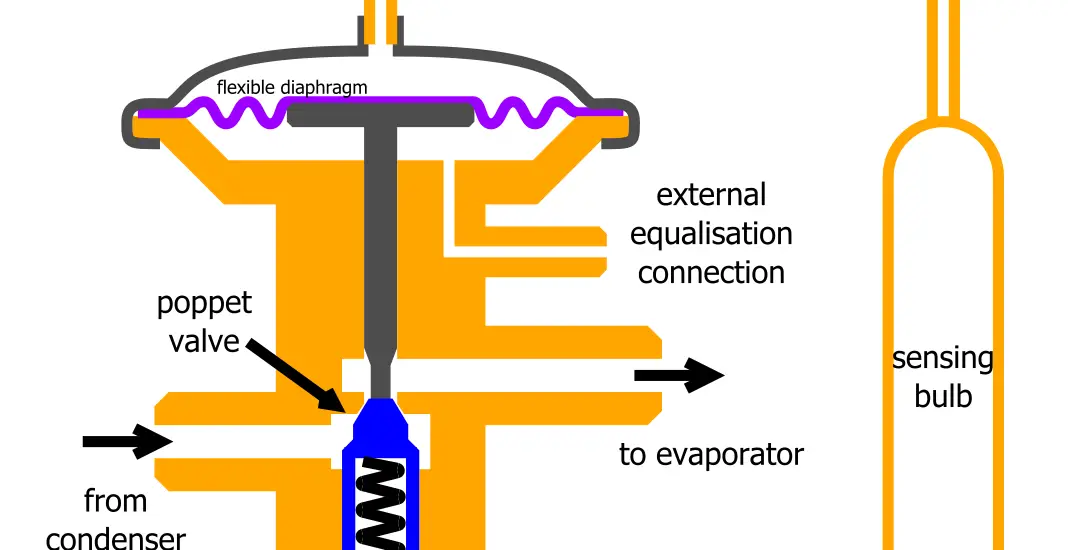This article will reveal all you need to know about the expansion valve orifice.

Table of Contents
Delving Deeper: What is an Expansion Valve Orifice?
The expansion valve orifice is a key player in the cooling world. Think of it as a gatekeeper, standing between two areas of an air conditioning system. On one side, you have high-pressure refrigerant (a fluid that helps in cooling) in its liquid form. This gatekeeper, or orifice, allows a controlled amount of this liquid to pass through to the other side, where it will face a lower pressure.
Now, why is this control important? When the liquid refrigerant moves from high to low pressure, it expands and evaporates into a gas, which gets cold in the process. This cold gas then travels around the system, absorbing heat and cooling down the surrounding area. So, the orifice’s role is crucial in determining how cold this gas gets and how effective your cooling system will be.
Expansion Valve vs Orifice Tube: Drawing Distinctions
Both the expansion valve and the orifice tube have a shared objective: managing refrigerant flow. However, the manner and the systems in which they operate tend to vary.
Expansion Valve: It is a multifaceted component that boasts several moving parts. It responds to the system’s needs, adjusting the refrigerant’s flow based on various factors like cooling demand, external temperatures, and the evaporator’s temperature. Its dynamic nature, coupled with its efficiency, makes it a popular choice for sophisticated systems, including commercial-grade HVAC systems.
Orifice Tube: In contrast, the orifice tube offers a fixed and unchanging operation. The simplicity of its design ensures a consistent opening for the refrigerant to traverse, with no adaptability to varying conditions. Its straightforwardness, coupled with its cost benefits, makes it a staple in automotive air conditioning units.
Making the Right Choice: Expansion Valve or Orifice Tube?
It’s like choosing between a smart thermostat and a regular one for your home. The expansion valve, being dynamic and adaptable, is akin to a smart thermostat. It senses the need and adapts, providing precise control over how much refrigerant is let through. This makes it perfect for complex systems where precision is essential.
On the other hand, the orifice tube is more like a regular thermostat. It’s simpler, more straightforward, and does its job without any adjustments. If you’re looking for something uncomplicated and cost-effective, especially for smaller systems, the orifice tube is a better fit.
Check out these other related articles…
Electronic Expansion Valve: Your Easy Guide
Expansion Valve Types: Your Comprehensive Guide
Expansion Valve in Refrigerator: Your Easy 101 Guide
Expansion Valve Function: Easy 101 Guide
Expansion Valve Chiller: Your Quick 101 Guide
Detecting Issues: Signs Your System May Be Malfunctioning
Just like how a car might show signs when something’s amiss, like making noises or stalling, your cooling system also has ways to signal potential problems. If your system isn’t cooling effectively, it might be because of issues with the expansion valve orifice or the orifice tube.
Cooling Efficiency Drops: If your room or car isn’t cooling down as it used to, it could be because the refrigerant isn’t passing through the valve or tube effectively.
Compressor Issues: The compressor is like the heart of your cooling system. If it’s constantly starting and stopping or not running at all, it might be struggling due to issues in the flow of refrigerant, which could stem from the valve or tube.
Frost or Ice Formation: Seeing frost outside your unit? It could mean the refrigerant isn’t flowing correctly. When it’s too slow or gets stuck, it can cause the surrounding moisture to freeze.
Whenever you notice these signs, it’s a good idea to get a professional to check your system. Just like you wouldn’t ignore strange noises from your car, don’t ignore these signs from your cooling system.